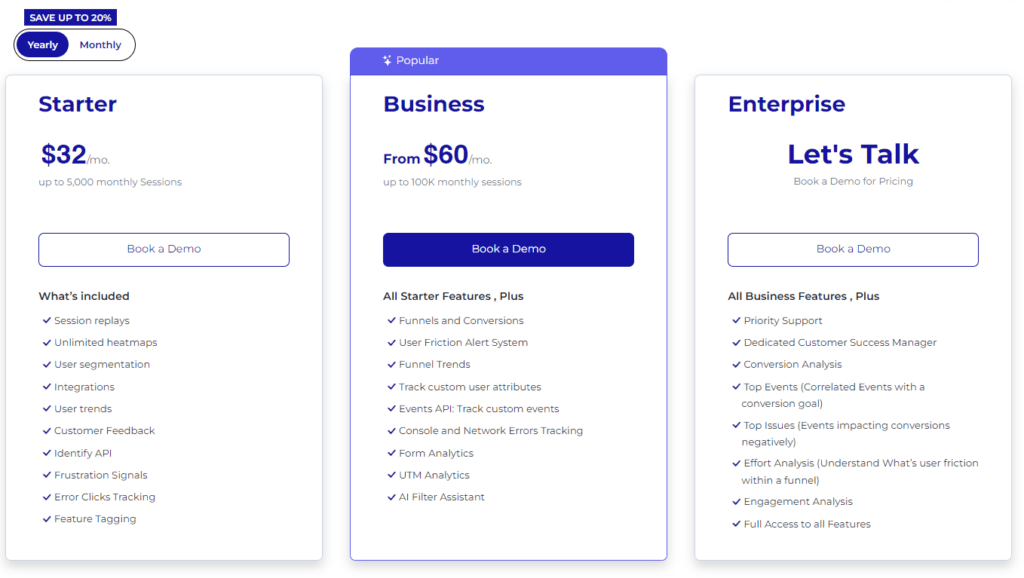Product usage analytics software help businesses track how users interact with their products, providing valuable insights to optimize user experiences...
Your product may be set to be the most revolutionary thing to grace your industry, but how do you know whether it will soar upon launch or crash and burn?
This is where product market fit comes in, and all startups go through this process. In essence, product market fit is when your product serves the needs of your target audience so well that it can practically sell itself.
The concept of product market fit is easy to grasp, but the process is more complicated beyond the surface level.
In this guide, we'll dive into the ins and outs of product market fit, why it's important, and a step-by-step guide on how to achieve it.
What is Product Market Fit?
Product market fit (PMF) is when your product or service solves the needs of your target market and provides them with a strong value proposition.
Marc Andreessen, a prominent figure in Silicon Valley and co-founder of the venture capital firm Andreessen Horowitz, provided a foundational definition of Product Market Fit (PMF) in 2007. He describes PMF as a situation in which a company's product is so in demand that it can essentially sell itself.
According to Andreessen, achieving Product-Market Fit means finding a good market for a product that can satisfy that market.
Understanding the Product Market Fit Pyramid
Dan Olsen introduced the Product Market Fit Pyramid as a conceptual framework to help companies achieve product-market fit.
This pyramid is a structured approach that breaks down the complex process of achieving product-market fit into five interrelated layers. It guides product teams through a systematic process from understanding user needs to delivering a product that meets those needs.
Source: Dan Olsen
Product market fit happens when the choices you make in the top three layers of the pyramid resonate with the target customer.
However, you must first start at the bottom two layers, which involves identifying your target market and figuring out what needs they need to be met.
Olsen recommends spending more time understanding the problem and the underserved customer before focusing on your solution. Many startups fail when they focus on their proposed solutions before they truly understand who they are targeting and what their needs are.
Why is Product Market Fit Essential to Business Success?
From a bird's eye view, achieving product market fit means you're serving your target customers exactly the way they need you to. In turn, the resources you've allocated are returning profit, and you're seeing a positive bottom line.
However, let's take the time to look at the role of product market fit in business success a little more closely:
Customer Satisfaction and Loyalty
When your product fits the market like a glove, it means you're solving a real problem or fulfilling a genuine need for your customers. This satisfaction is the bedrock of customer loyalty, as happy customers are more likely to stick around.
Organic Growth and Word-of-Mouth
A product that hits the PMF sweet spot tends to generate buzz organically. Satisfied customers become advocates, spreading the word to friends, family, and colleagues. This word-of-mouth marketing is gold—it's authentic, persuasive, and, best of all, free.
Easier Customer Acquisition
A product that's in demand and fits the market well typically sees higher conversion rates. Marketing and sales efforts yield better results because the message resonates more strongly with the target audience, so it’s easier to attract and convert leads.
Sustainability and Growth
Achieving product market fit is an important milestone that can set the stage for sustainable growth. Once you hit PMF, you can then start focusing on optimizing your growth rate.
Competitive Advantage
In a crowded market, the products that best meet target customer needs are the ones that stand out. PMF provides a significant competitive edge, making it harder for competitors to lure away your customers if your product best solves their problems.
Fundraising and Investment Opportunities
For startups especially, demonstrating that your product has achieved market fit can open doors to investment and funding opportunities. Investors are more inclined to invest in businesses with proven market demand, as this significantly lowers their risk.
How to Test Product Market Fit
Testing for product market fit is an iterative process that hinges on understanding your customers deeply and tailoring your product to meet their needs as closely as possible. This process typically involves seven steps:
Step 1: Identify Your Target Customer
The first step is to identify what market you're targeting and the characteristics of the customers within that market. This often involves a mix of demographic and psychographic analysis to sketch out a clear picture of your ideal customer. Think about their age, location, hobbies, and lifestyle.
Creating detailed customer personas at this stage can be incredibly helpful. They provide a tangible reference point for whom you're aiming to serve with your product.
Step 2: Understand the Needs of Your Target Customer
Once you know who your customers are, the next step is to get into their shoes and really understand what they need. This means rolling up your sleeves and diving into market research—conduct surveys, hold interviews, or run focus groups to unearth the real challenges they face.
What are your potential customers trying to achieve, and how can you help them?
Additionally, a keen eye on your competition can reveal unmet needs and opportunities for differentiation, guiding you toward how your product can fill those gaps.
Step 3: Define Your Unique Value Proposition
With a clear understanding of your target customers and their needs, it's time to articulate your unique value proposition (UVP).
A value proposition is the total of a buyer's perceived benefits from your product. This is where you define how your product solves your customers' problems in ways that other products don't.
Your UVP should spotlight what sets your product apart, focusing on the unique benefits and features that make it the superior choice. Consider zeroing in on a niche problem with a limited target market before you scale to advanced solutions, especially if you're a startup with limited resources.
Step 4: Identify Your Minimum Viable Product (MVP)
The concept of the MVP is central to the lean startup methodology—identify the most basic version of your product that still solves your customers' problems. This step is about distilling your product down to its essence, focusing on core features that deliver real value without the frills.
The MVP serves as your initial offering to test the market's response to your core value proposition. When you keep your MVP simple, it's easier to test and develop it through customer feedback.
Step 5: Build an MVP
With the blueprint of your MVP in hand, it's time to build your prototype. This phase is all about turning theory into reality, creating a functional product that embodies your UVP with just the necessary features.
The aim here is speed and efficiency; develop your MVP swiftly, but ensure it's a credible representation of what your product stands for.
Step 6: Test Your MVP With Target Customers
Now comes the moment of truth—introducing your MVP to a select group of target customers. This pilot testing phase is crucial for observing how real users interact with your product in a natural setting.
It's not just about whether they use your product but also how they use it, which features resonate with them, and where they encounter difficulties.
Step 7: Collect Feedback and Improve
The final step in this initial cycle is all about learning from the feedback you've gathered. This involves collecting and measuring both qualitative and quantitative metrics through various methods, such as:
- Surveys or questionnaires
- Interviews
- Focus groups
- Web analytics
Use this feedback to refine your product, making necessary adjustments to better meet your customers' needs. Amplify the features your test customers love the most and improve or eliminate the things they don’t like.
Now, the question is: how do you know if you have product market fit?
How to Tell if You Have vs Don't Have Product Market Fit
It can be way too easy to conclude that you have product market fit when, in fact, you don't. To get this potential issue out of the way, let's talk about how to tell if you have product market fit vs when you don't:
Signs You Have Product Market Fit
You most likely have achieved product market fit if you see:
- High Customer Satisfaction: Customers not only use your product but love it. They're often enthusiastic and provide positive customer feedback. Plus, you're seeing a positive net promoter score (NPS) and customer satisfaction score (CSAT).
- Organic Growth: You're experiencing word-of-mouth referrals. New customers find you through the recommendations of existing ones without you having to spend a fortune on marketing. You also notice a lower customer acquisition cost (CAC).
- High Retention Rates: Once customers start using your product, they stick around. A strong retention rate indicates that your product is not just a passing interest but a lasting solution.
- Increased Usage: Users are engaging with your product frequently. Whether it's daily, weekly, or monthly, the usage fits the expected pattern for your type of product and shows that it's become a part of their routine.
- Customers Pay for Your Product: This might sound obvious, but if customers are willing to pay for your product—and especially if they're willing to prepay or sign long-term contracts—that's a strong signal of product market fit.
- Ease of Sales: Selling your product doesn't feel like pushing a boulder uphill. Potential customers understand its value and are eager to adopt it without needing heavy persuasion.
Signs You Don't Have Product Market Fit
In contrast, you might not have achieved product market fit if you experience:
- Low Customer Engagement and Feedback: If customers aren't using your product much or providing feedback, it's a sign they're not finding it valuable or compelling.
- High Churn Rate: Customers try your product but quickly leave. High churn rates suggest that your product isn't meeting long-term needs or expectations.
- Difficulty in Acquiring Customers: If acquiring each new customer feels like a battle, it might be a sign that your product isn't resonating with the target market.
- Reliance on Heavy Discounts or Promotions: Needing to offer discounts or promotions to attract users constantly can indicate a lack of genuine interest or value perception in your product.
- Lackluster Word-of-Mouth: If your customers aren’t naturally talking about or recommending your product to others, it's often a sign that it's not making a significant impact on their lives.
- Feedback Indicates a Mismatch: Direct feedback from customers that your product doesn't solve their problem, or doesn't do it well enough, is a clear indication that you haven't found the right market fit.
How to Measure Product Market Fit
Learning how to determine product market fit can be tricky if you aren't sure what metrics to look at. Businesses need to measure product market fit to understand how well their products serve market demand and to do that, they need to ask specific questions and track key metrics.
Questions to Ask
Surveys are the best tool to measure product market fit through user feedback. A mixture of close-ended questions, open-ended questions, and multiple-choice questions tends to work best for most business models.
Open-ended questions
Open-ended questions allow respondents to answer in their own words, providing qualitative data. They are invaluable for uncovering insights that might not be anticipated by the survey creators.
In measuring PMF, open-ended questions offer depth and detail, revealing the reasons behind user behaviors, preferences, and sentiments.
They can uncover nuanced feedback on user experience, suggestions for improvement, and detailed perceptions of the product’s value.
- What do you like most about our product?
- If you could change one thing about our product, what would it be?
- Why do you prefer our product over alternatives? Please explain.
Close-ended questions
Close-ended questions provide respondents with a set of predefined answers, producing quantitative data. They are easy to analyze and can quickly highlight trends and patterns in how a product meets market needs.
In PMF surveys, close-ended questions are useful for measuring specific aspects of user interaction and satisfaction, such as frequency of use, preference over competitors, and the likelihood of recommending the product (Net Promoter Score, NPS).
- Have you recommended our product to anyone?
- Yes
- No
- Do you find our product easy to use?
- Yes
- No
- Are you likely to continue using our product in the next 6 months?
- Yes
- No
- Unsure
Multiple choice questions
Multiple choice questions offer respondents a list of predefined options from which they can select one or more answers. This format is particularly effective for categorizing user responses into distinct groups or preferences, making the data easier to collect and analyze.
When measuring PMF, multiple choice questions can efficiently gauge user preferences, behaviors, and characteristics. They can quantify aspects such as feature popularity, usage frequency, and satisfaction levels.
- What is the primary reason you use our product?
- To save time
- Ease of use
- Cost-effectiveness
- Unique features not available elsewhere
- Other (Please specify)
- How often do you use our product?
- Daily
- Weekly
- Monthly
- Rarely
Key Metrics to Track
What metrics do you need to look into to determine product market fit? There are quite a few key performance indicators (KPIs) that play crucial roles in measuring PMF, but here are the most important ones:
Customer Retention Rate
Retention rate measures how many customers continue to use your product over a specific period. High retention rates are a strong signal of PMF, indicating that users find continued value in your product.
Churn Rate
Conversely, churn rate is the percentage of customers who stop using your product during a certain time frame. A low churn rate suggests that you're maintaining a good fit with your market's needs.
Net Promoter Score (NPS)
NPS gauges customer satisfaction and loyalty by asking customers how likely they are to recommend your product on a scale of 0 to 10. A high NPS indicates that your customers are not only satisfied but also enthusiastic advocates of your product.
Usage Frequency
This metric tracks how often users engage with your product. Regular use suggests that your product is an essential part of their routine or workflow, signaling a strong product-market fit.
Growth Rate
A steady or accelerating rate of new user acquisition can indicate that your product is resonating with the target market. It's important to differentiate organic growth from growth driven by marketing spend, as the former is more indicative of PMF.
Conversion Rate
The conversion rate from trial to paid customers or from first-time visitors to active users can reveal how compelling your value proposition is to potential customers. High conversion rates often reflect a product that effectively meets market needs.
Customer Feedback and Sentiment Analysis
Qualitative feedback from user reviews, surveys, and direct communications can provide deep insights into customer satisfaction and areas for improvement. Positive sentiment generally correlates with good product-market fit.
Achieve Product Market Fit With Data-Driven Insights
Reaching product market fit is all about finding a good market and developing your product to serve that market perfectly. But, as you can tell by now, that process is quite complicated. More precisely, it requires a lot of data.
FullSession can help you collect, measure, and analyze all the data you need with a full stack of intuitive tools:
- Session recordings and replays capture and store user interactions with your product, allowing you to watch replays of user sessions. It provides a visual understanding of how users navigate your platform, where they spend time, and where they encounter issues.
- Interactive heatmaps visually represent where users click, scroll, and move within your web pages or app interfaces. This data is aggregated from multiple sessions to highlight patterns of interaction.
- Customer feedback tools make direct communication with users easy through surveys, feedback forms, and suggestion boxes embedded within your product or sent via email.
- Market segmentation tools analyze user data to segment your audience based on demographics, behavior, and usage patterns. Segmentation can be as simple or complex as needed, ranging from basic demographic splits to more nuanced behavior-based groups.
FullSession Pricing Plans

The FullSession platform offers a 14-day free trial. It provides two paid plans—Basic and Business. Here are more details on each plan.
- The Starter plan costs $39/month or $32/year and allows you to monitor up to 5,000 monthly sessions with up to 6 months of data storage.
- The Business plan costs $75/month or $60/year and helps you to track and analyze up to 100,000 monthly sessions with up to 12 months of data storage.
- The Enterprise plan has custom pricing and offers customizable sessions plus full access to all features.
Test Product Market Fit With FullSession
It takes less than 5 minutes to set up your tools for product market fit testing, with FullSession, and it's completely free!
FAQs About Product Market Fit
How long does it take to find product-market fit?
It's not an overnight affair. It can take several iterations and months of testing and feedback. Startups should focus on measuring and testing product market fit during their first few months or years.
Can product-market fit change over time?
Absolutely. Markets evolve, and so do customer needs. Thus, your product-market fit will change along with the tides. Keep your ear to the ground to make sure you keep your PMF positive.
Is the product-market fit the same for every industry?
While the concept is universal, the specifics can vary wildly between industries and market segments.





